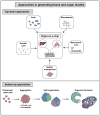Three-dimensional models for studying development and disease: moving on from organisms to organs-on-a-chip and organoids
- PMID: 27156572
- PMCID: PMC4905804
- DOI: 10.1039/c6ib00039h
Three-dimensional models for studying development and disease: moving on from organisms to organs-on-a-chip and organoids
Abstract
Human development and disease are challenging to study because of lack of experimental accessibility to in vivo systems and the complex nature of biological processes. For these reasons researchers turn to the use of model systems, ranging in complexity and scale from single cells to model organisms. While the use of model organisms is valuable for studying physiology and pathophysiology in an in vivo context and for aiding pre-clinical development of therapeutics, animal models are costly, difficult to interrogate, and not always equivalent to human biology. For these reasons, three-dimensional (3D) cell cultures have emerged as an attractive model system that contains key aspects of in vivo tissue and organ complexity while being more experimentally tractable than model organisms. In particular, organ-on-a-chip and organoid models represent orthogonal approaches that have been able to recapitulate characteristics of physiology and disease. Here, we review advances in these two categories of 3D cultures and applications in studying development and disease. Additionally, we discuss development of key technologies that facilitate the generation of 3D cultures, including microfluidics, biomaterials, genome editing, and imaging technologies.
Figures




Similar articles
-
Patient-Specific Organoid and Organ-on-a-Chip: 3D Cell-Culture Meets 3D Printing and Numerical Simulation.Adv Biol (Weinh). 2021 Jun;5(6):e2000024. doi: 10.1002/adbi.202000024. Epub 2021 Apr 15. Adv Biol (Weinh). 2021. PMID: 33856745 Free PMC article. Review.
-
Developmentally inspired human 'organs on chips'.Development. 2018 May 18;145(16):dev156125. doi: 10.1242/dev.156125. Development. 2018. PMID: 29776965 Free PMC article.
-
3D culture models for studying branching morphogenesis in the mammary gland and mammalian lung.Biomaterials. 2019 Apr;198:135-145. doi: 10.1016/j.biomaterials.2018.08.043. Epub 2018 Aug 23. Biomaterials. 2019. PMID: 30174198 Free PMC article. Review.
-
A brief history of organoids.Am J Physiol Cell Physiol. 2020 Jul 1;319(1):C151-C165. doi: 10.1152/ajpcell.00120.2020. Epub 2020 May 27. Am J Physiol Cell Physiol. 2020. PMID: 32459504 Free PMC article. Review.
-
Organoids in Dynamic Culture: Microfluidics and 3D Printing Technologies.ACS Biomater Sci Eng. 2025 Jun 9;11(6):3165-3181. doi: 10.1021/acsbiomaterials.4c02245. Epub 2025 Apr 18. ACS Biomater Sci Eng. 2025. PMID: 40248908 Review.
Cited by
-
Novel Strategies in Artificial Organ Development: What Is the Future of Medicine?Micromachines (Basel). 2020 Jun 30;11(7):646. doi: 10.3390/mi11070646. Micromachines (Basel). 2020. PMID: 32629779 Free PMC article. Review.
-
Organoids of epithelial ovarian cancer as an emerging preclinical in vitro tool: a review.J Ovarian Res. 2019 Nov 8;12(1):105. doi: 10.1186/s13048-019-0577-2. J Ovarian Res. 2019. PMID: 31703723 Free PMC article. Review.
-
OrgaQuant: Human Intestinal Organoid Localization and Quantification Using Deep Convolutional Neural Networks.Sci Rep. 2019 Aug 28;9(1):12479. doi: 10.1038/s41598-019-48874-y. Sci Rep. 2019. PMID: 31462669 Free PMC article.
-
In vitro high-content tissue models to address precision medicine challenges.Mol Aspects Med. 2023 Jun;91:101108. doi: 10.1016/j.mam.2022.101108. Epub 2022 Aug 17. Mol Aspects Med. 2023. PMID: 35987701 Free PMC article. Review.
-
Patient-Derived Tumor Organoids for Drug Repositioning in Cancer Care: A Promising Approach in the Era of Tailored Treatment.Cancers (Basel). 2020 Dec 4;12(12):3636. doi: 10.3390/cancers12123636. Cancers (Basel). 2020. PMID: 33291603 Free PMC article. Review.
References
-
- Elsea SH, Lucas RE. ILAR journal/National Research Council, Institute of Laboratory Animal Resources. 2002;43:66–79. - PubMed
Publication types
MeSH terms
Grants and funding
LinkOut - more resources
Full Text Sources
Other Literature Sources

